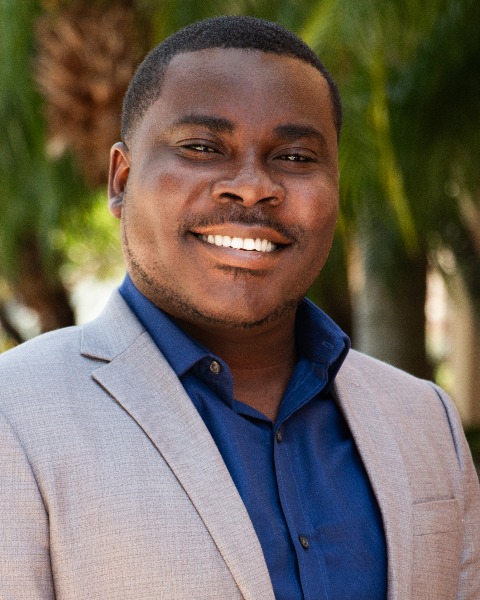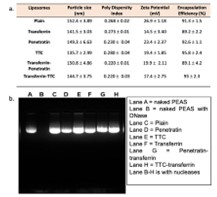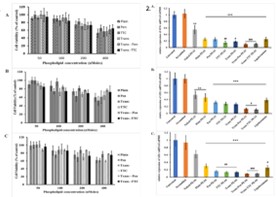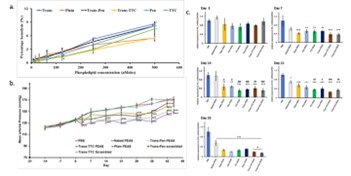Formulation and Delivery - Biomolecular
Category: Poster Abstract
(M1030-02-10) Dual Functionalized Liposomal Nanoparticles Can Deliver Plasmid Encoding for Angiotensin II Receptor shRNA to the Brain of Spontaneously Hypertensive Rats to Reduce Blood Pressure
Monday, October 23, 2023
10:30 AM - 11:30 AM ET

Richard NL Lamptey, PhD
Assistant Professor
Palm Beach Atlantic University
West Palm Beach, Florida, United States- JS
Jagdish Singh, Ph.D. (he/him/his)
North Dakota State University
Fargo, North Dakota, United States - CS
Chengwen Sun, Ph.D.
North Dakota State University
Fargo, North Dakota, United States
Presenting Author(s)
Main Author(s)
Co-Author(s)
Purpose: A considerable increase in Angiotensin II-mediated sympathetic nervous system activity within the brain characterizes neurogenic hypertension (NH). Using Angiotensin II receptor gene silencing nucleic acids, several studies have demonstrated the ability to control blood pressure in NH. These treatments, however, have used invasive methods to administer these genes, limiting their clinical applicability. As a result, a less intrusive and more targeted gene delivery technique for delivering medications to the brain could be a viable therapeutic strategy. Liposomes have a high potential for this function since they can entrap nucleic acids, protect them in vivo, and distribute them to specific locations. Liposomes can be functionalized in order to avoid the bodies clearance mechanism and induce biased distribution into specific organs such as the brain. Herein we investigate the delivery of plasmid DNA encoding angiotensin receptor shRNA (PEAS) to the brain safely. We developed and characterized dual functionalized liposomes as a therapeutic method for delivering PEAS into rats' brains. Our long-term goal is to create a treatment for NH.
Methods: Active ligands were incorporated by initially conjugating Penetratin, nontoxic tetanus toxin Fragment C (TTC), and Transferrin to activated NHS-terminated DSPE-EG2000. Liposomes were synthesized using the thin film hydration technique and characterized for size, zeta potential and polydisperty by the dynamic light scattering. The amount of pDNA encapsulated was investigated as well as the ability of the liposomes to protect the loaded pDNA. Brain derived cell lines were used to investigate the in vitro biocompatibility and transfection efficacies of the PEAS-loaded liposomes. In vivo efficacy of PEAS loaded liposomes were investigated in spontaneously hypertensive rats and the extent of AT1r gene knockdown was estimated over time.
Results: This study synthesized cationic dual-functionalized liposomes loaded with PEAS. A carbodiimide crosslinker reaction was used to introduce the active ligands, penetratin, TTC, and transferrin, to the liposomes as DSPE-Peg conjugates. The hydrodynamic diameter of the liposomes was an average of 150 nm, and the size distribution was uniform as seen from the PDI being below 0.3 All formulations presented with a positive surface charge, which can be attributed to the presence of the cationic phospholipid DOTAP. The encapsulation efficiencies of PEAS were found to be greater than 80% in all different liposomal nanoparticles and all liposomes were able to protect plasmid DNA from DNase degradation. Biocompatibility studies in brain derived cell lines revealed a concentration dependent toxicity with greater than 80% cell survival in the presence of 100 nMoles phospholipid. The ability of liposomal encapsulated PEAS to reduce gene expression was investigated in primary astrocytes, primary neurons, and bEnd.3 cells. Successful transfection with PEAS resulted in a significant (p < 0.05) reduction in AT1r gene expression by day 3 using the unfunctionalized formulation. Dual functionalized formulations showed the greatest reduction in AT1r gene expression resulting in over 70% gene knockdown in all different brain derived cell lines. All formulations exhibited concentration-dependent toxicity in erythrocytes, with hemolysis activity remained below 3% even at 125 nMoles of phospholipid. In vivo efficacy studies showed that dual-functionalized liposomes showed the greatest reduction in gene expression, while plain PEAS-loaded liposomes showed a significant gene knockdown beginning from day 14. Dual functionalized formulations resulted in a significant (p < 0.001) reduction in blood pressure. No major behavioral changes were observed in all rats, and tissue sections stained with hemotoxin and eosin showed no signs of necrosis or tissue damage.
Conclusion: This study synthesized cationic dual-functionalized liposomes loaded with PEAS. The hydrodynamic diameter of the liposomes was ~150 nm with PDI below 0.3. Liposomes were able to encapsulate >80% plasmid and protect it from DNase. Liposomes were found to be biocompatible with brain derived cell lines and erythrocytes. This study investigated the efficacy of liposomes to knock down the brain AT1r gene and reduce protein levels. Results showed that dual-functionalized liposomes showed the greatest reduction in gene expression, while plain PEAS-loaded liposomes showed a significant gene knockdown beginning from day 14. No major behavioral changes were observed, and tissue sections stained with hemotoxin, and eosin showed no signs of necrosis or tissue damage.
Acknowledgements: This research was supported by National Institutes of Health Grants R01 AG051574 and RF1 AG068034 and 3RF1AG068034-01A1S1
 a. Characterization of PEAS-loaded liposomes for particle size, polydispersity index, and surface charge (zeta potential) b. DNAse protective effect of chitosan-PEAS (N/P 1: 10) loaded liposomal formulation.
a. Characterization of PEAS-loaded liposomes for particle size, polydispersity index, and surface charge (zeta potential) b. DNAse protective effect of chitosan-PEAS (N/P 1: 10) loaded liposomal formulation. 1. In vitro cellular viability of A) b.End3 s B) primary astrocytes and C) primary neuronal cells following exposure to PEAS-loaded liposomes at different phospholipid concentrations (50, 100, 200, and 400 nMoles). 2. AT1r gene expression in A) primary neurons, B) primary astrocytes, and C) b.End3 cells at day 7 following transfection of different PEAS-loaded liposomes
1. In vitro cellular viability of A) b.End3 s B) primary astrocytes and C) primary neuronal cells following exposure to PEAS-loaded liposomes at different phospholipid concentrations (50, 100, 200, and 400 nMoles). 2. AT1r gene expression in A) primary neurons, B) primary astrocytes, and C) b.End3 cells at day 7 following transfection of different PEAS-loaded liposomes . a. Percentage hemolytic activity of PEAS-loaded liposomal formulations. The hemolysis observed with PBS and 1% v/v Triton X-100 was considered as no hemolysis, and 100% hemolysis respectively b. Mean arterial pressure measurements of SHR upon administration of PEAS loaded liposomes c. AT1r mRNA levels in the SHR brain at different time points following PEAS administration with different formulations. Data expressed as mean ± SEM (n = 6 biologically independent samples). Statistically significant differences (p < 0.05, 0.01, 0.001) differences with PBS-treated and naked PEAS treated are shown as (*, **, ***), and (#, ##, ###), respectively
. a. Percentage hemolytic activity of PEAS-loaded liposomal formulations. The hemolysis observed with PBS and 1% v/v Triton X-100 was considered as no hemolysis, and 100% hemolysis respectively b. Mean arterial pressure measurements of SHR upon administration of PEAS loaded liposomes c. AT1r mRNA levels in the SHR brain at different time points following PEAS administration with different formulations. Data expressed as mean ± SEM (n = 6 biologically independent samples). Statistically significant differences (p < 0.05, 0.01, 0.001) differences with PBS-treated and naked PEAS treated are shown as (*, **, ***), and (#, ##, ###), respectively